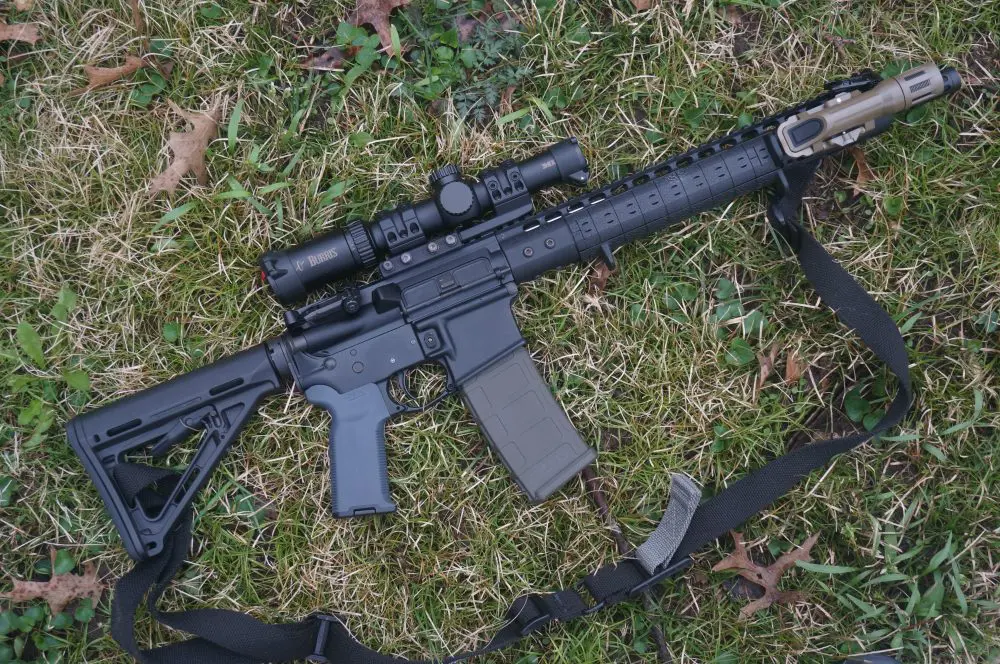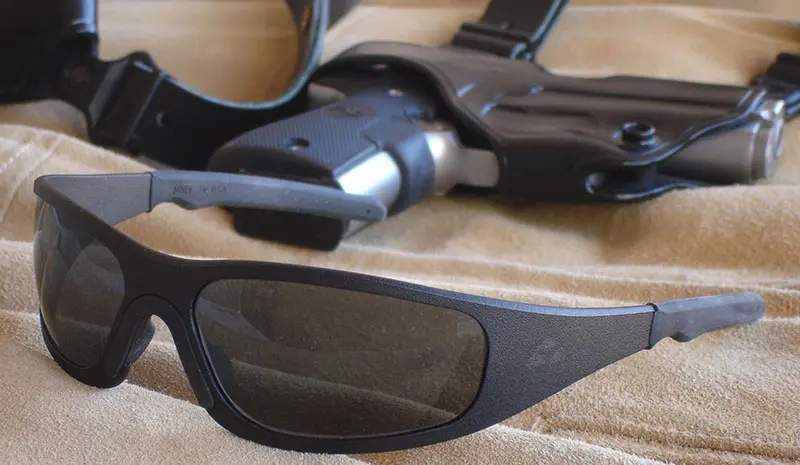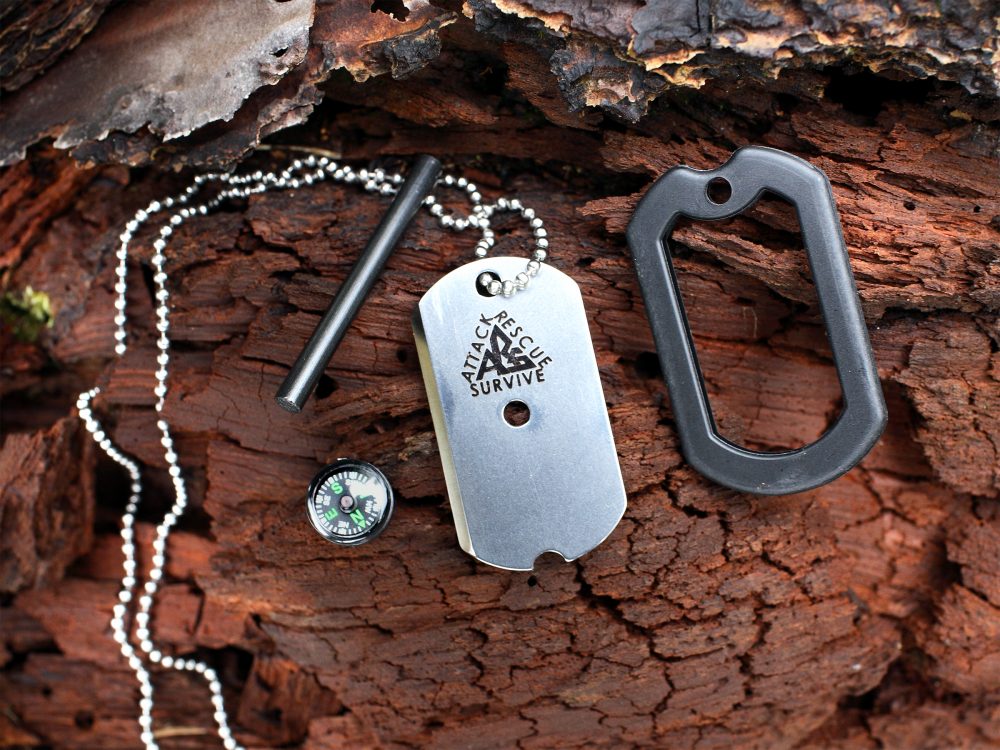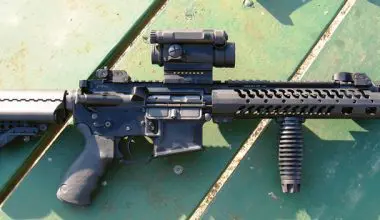In mid-May 2009, Sturm, Ruger & Company (Ruger) surprised the firearms community with the announcement that the company would start producing an AR-15-type rifle—the Ruger SR 556.
Some have posed the question, “Do we really need another manufacturer producing an AR type rifle?” With the current supply and demand situation, coupled with the uncertainty about what “The One” and his minions will do in the next few years, I believe the answer is a resounding “YES!”
Having toured Ruger’s plants on more than one occasion, I had no doubt that, if they put their minds to it, they could produce a high-quality rifle that may well be the equal to that of any manufacturer. I placed an order for a test and evaluation rifle, received it in the first half of June and have spent many hours on the range with it since then.
Table of Contents
THE Ruger SR-556
Unlike most, but not all, AR-type rifles, the SR-556 does not work on Eugene Stoner’s direct gas impingement (DI) design, but rather on an innovative, patent-pending, two-stage piston-driven design.
The advantage of a piston-driven design is that almost no carbon builds up on the bolt carrier compared to a DI design and therefore it requires less maintenance. While I’m sure this is important to some folks, to be completely honest, I have never found properly lubricating a carbine to be much of a chore.
In DI designs, gas is vented toward the end of the barrel and travels down the gas tube, which causes the bolt carrier to travel rearward, ejecting the spent case and chambering a fresh round. The SR-556 will run cooler because combustion residue is vented through the bottom of the gas block.
With the SR-556 there is no need to worry if the carrier key screws are properly staked—there are none. The carbine utilizes a one-piece bolt carrier. Also, due to the piston design, the tail of the bolt itself is different from a standard AR bolt and does not employ gas rings. The SR-556 utilizes a heavy contour, 16 1/8-inch chrome-lined, cold hammer forged barrel. Made from milspec 41V45 chrome-moly-vanadium steel, it is chambered in 5.56mm NATO (and will also fire .223 Remington) with a twist rate of 1:9. While I personally would have preferred a 1:7 or 1:8 twist, most folks will probably use the more readily available 55-gr. ammunition that is stabilized very well with the 1:9 twist, so the point is probably moot. The flash suppressor used is the same as that used on the Ruger AC-556 and GB model Mini-14 carbines.
At the front of the gas block is a four position gas regulator, numbered from 0 to 3, allowing the shooter to adjust the carbine to ammunition and conditions. The “0” position does not allow any gas to pass through the regulator and will allow the SR-556 as a single-shot rifle using the charging handle. The other three
positions allow gas to pass through the block, with “1” being the smallest amount and “3” the largest. The Ruger manual advises that “2” is a good starting point for most 5.56/.223 loads.
A one-piece Troy Industries Quad Rail handguard is used on the SR-556. This ten-inch rail is “T” marked (numbered) out to slot number 40, providing ample real estate for mounting iron sights, optics, flashlights, lasers, vertical foregrips, etc. Made exclusively for Ruger by Troy, the handguard is pinned to the upper receiver. Three Troy six-inch rail covers are included to protect the rails.
The SR-556 comes standard with Troy Industries Folding BattleSights. These sights are very rugged and are considered by some experts to be the gold standard in folding backup iron sights. The sights can be easily deployed into the up position with a flip of a finger, and folded down with a push of a button.
The front sight is adjustable for elevation, while the rear sight is adjustable for windage and features small and large apertures.
Furniture on the Ruger carbine consists of the ergonomic Hogue Monogrip pistol grip and a six-position M4-type collapsible stock. A milspec buffer and spring are used in the stock.
Attention has been paid to the finish on all parts. As mentioned earlier, the barrel is chrome lined, as is the interior of the gas block. The bolt, bolt carrier and extractor are chrome plated, and the piston-driven transfer rod is finished with a nickel/Teflon coat. Steel parts are Parkerized, while all aluminum parts are hard coat anodized.
One of my pet peeves over the years has been manufacturers who consider magazines to be “accessories.” A semiautomatic firearm without a magazine is a poor substitute for a Louisville Slugger. The SR-556 comes complete with three 30-round Magpul PMAGs.
The SR-556 comes in a padded carry case that is emblazoned with the Ruger logo. A locking device and an instruction manual are also included. The nylon parade sling that many rifle manufacturers include does not come with the SR-556 and won’t be missed, since most serious shooters will replace it with a more suitable sling anyway.
FIELD EVALUATION
My first impression of the SR-556 was that it was muzzle heavy due to the long Troy quad rail, but not unreasonably so. I also thought, however, that the increased weight may help reduce muzzle rise during rapid fire.
For optics, I chose to mount an EOTech 553 on the top rail.
Four different loads from Black Hills Ammunition were used for the T&E: the 50-gr. V-MAX, 55-gr. FMJ, 68-gr. Match and 77-gr. Match. In addition, I used a quantity of my own reloads.
The first load through the SR-556 was the 50-gr. V-MAX. In order to check out the gas regulator, I set the regulator on “1.” Somewhat predictably, spent loads were ejected, but apparently there was not enough pressure to drive the bolt far enough rearward to pick and chamber a fresh round from the magazine. The regulator was reset on “2,” which resulted in perfect functioning, and the regulator was left in that position for the remainder of the evaluation.
In reviewing the carbine with the thought that peace officers and private citizens will use it as a defensive firearm, the farthest distance I fired the SR-556 was 50 yards—well within engagement
distances for the vast majority of law enforcement shootings. All five loads used in the Ruger grouped right at or slightly over one inch at 50 yards, fired from prone using the magazine as a monopod for support.
I have no doubt that, with a carefully chosen load and using a magnifying optic, the SR-556 could be an accurate varmint rifle at longer distances. However, the primary focus of S.W.A.T. tests is to evaluate firearms from a tactical perspective, and I will leave the hunting aspect to publications that specialize in that field.
In June and July, I fired approximately 600 rounds through the SR-556. These were more plinking sessions than hard use, firing perhaps 100-150 rounds each time.
In mid-August, it was time to get down to business. My grandson Austin helped me pre-load fifty 30-round magazines (loaded to 28 rounds) for use over the next two days. I fired multiple drills from Pat Rogers’ three-day Carbine Operators Course. With what is normally three days of shooting condensed into two days, the firing schedule was, shall we say, brisk.
For magazines, I used Magpul PMAGs, Lancer L5 translucent mags, black Teflon mags from Bravo Company with enhanced Magpul followers, and older GI mags also equipped with the Magpul followers.
As expected, the forward weight of the Troy rail did indeed help to stabilize muzzle rise when firing a Non Standard Response (NSR), which is more than the usual two rounds fired. As in Pat Rogers’ courses, for testing purposes an NSR consisted of seven rounds fired quickly enough to sound and feel almost like a burst on full-auto.
I had kept the carbine lubed as per my usual maintenance schedule. On the second day of the “course,” however, I decided to deviate from Pat’s course and put the piston system to an extreme test.
The bolt group was removed from the carbine, and it and the inside of the upper receiver were wiped dry. I proceeded to the carbine at a fairly fast rate, going through 11 magazines in just over 15 minutes before I started to experience feeding problems midway through the twelfth magazine, or just over 300 rounds.
I opened the bolt and placed the carbine in the shade, and even with a gentle breeze blowing through the receiver, the carbine’s barrel was too hot to touch after ten minutes.
Did the above prove anything? I think so, as the chance of a peace officer or citizen firing over 300 rounds in 15 minutes from a carbine with no lubrication is somewhere between slim and none.
Still, it’s nice to know that the SR-556 can run that hard, that long. (By way of comparison, I conducted the same test with a DI carbine and began experiencing malfunctions at slightly under 200 rounds.)
After the carbine cooled, the bolt group was removed, re-lubricated and “normal” testing resumed.
During a hydration break, the SR-556 was sitting in the range gun rack with the bolt open. An unexpected dust devil swept across the range and did a terrific job of depositing fine dirt in the carbine’s upper and lower receiver. Testing opportunity!
After a dry patch was run down the carbine’s bore to remove any dirt from the barrel, I finished the evaluation by firing four runs of the Modified Navy Qual. The drill consists of having three
magazines loaded with only five rounds each—one in the gun and two on the body. Fire five rounds from standing, reload and assume kneeling, fire five rounds, reload and assume prone, fire five rounds. Par time for the drill is 25 seconds.
Even with the dust and dirt deposited from the dust devil, the SR-556 continued to function. There were
also no problems inserting magazines or having them drop free during reloading.
Finally, the barrel was thoroughly cleaned and the carbine fired for group size one last time. The size of the ten round group had not measurably changed from the beginning of the test.
SUMMARY
In my opinion, Ruger got this one (as with so many of their other products) right. I ran the SR-556 hard, almost to the point of abuse, and it kept right on performing.
My initial plan had been to put around 2,500 rounds through the carbine, but after firing over 2,000 rounds—and it performing extremely well—I believe additional shooting would only have been a waste of powder.
To be completely honest, I’m still not convinced that a piston-driven AR is better than one using the direct
impingement design, assuming the DI is properly lubricated. That the piston design runs cleaner and deposits less carbon and crud onto the bolt group is indisputable: the bolt of the SR-556 appeared almost as clean at the end of the test as it did at the beginning.
I believe that anyone purchasing an SR-556 for a patrol rifle/defensive use can rest assured they’ll be going in harm’s way with a quality, reliable firearm.





